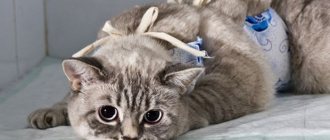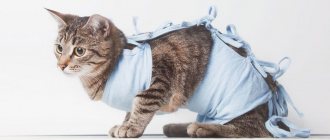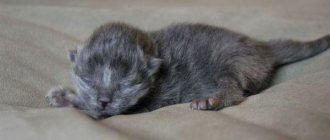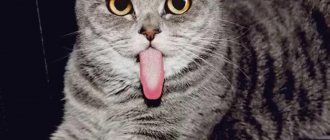What could be the consequences of sterilization?
The general condition and behavior of the cat after sterilization changes daily.
Day 1
On the first day after surgery, the cat has no appetite, lethargy, drowsiness, coordination of movements is impaired, hallucinations and disorientation may occur - the pet tries to run or crawl in an unknown direction, stops abruptly, runs into walls, falls and falls asleep, jumps up, etc. This behavior is normal and there is no reason to worry.
The cat may not blink, in which case it is necessary to close her eyes yourself until she starts blinking again, otherwise there is a risk of drying out the cornea.
In addition, involuntary urination and vomiting are possible.
On the first day after sterilization, you need to be close to your pet and monitor its condition. You cannot feed the animal, but only give it water from a syringe or pipette.
Day 2
During the second day, the cat begins to come to its senses, its behavior becomes more adequate. The pet has a desire to hide in dark, hard-to-reach places, so it is necessary to monitor it and constantly keep it in sight.
If a cat is in pain, it may try to bite someone who tries to touch it.
At this time, the animal shows a desire to lick the area near the incision and reacts too excitedly to all extraneous sounds.
On the second day, you can put water near the animal and start feeding it in small portions.
Day 3
On the third day, the cat fully comes to her senses: she is active, reacts with interest to what is happening around her, goes to the litter box and begins to ask for food.
You need to measure your pet’s body temperature twice and, if the readings are elevated or decreased, contact your veterinarian.
Due to the fact that anesthesia can slow down intestinal motility, it is necessary to monitor the regularity of bowel movements and, in the absence of bowel movements, you can give the cat mild laxatives.
Day 4
On the third day after sterilization, the cat should eat and drink independently, and should actively urinate and defecate.
Day 5
On the fifth day, the swelling and redness near the suture subsides, and scarring begins.
The cat is becoming more and more active and can now walk around the apartment.
And if before the operation the pet had access to the street, then into the yard, you can jump on low surfaces.
Day 6 and 7
By this time, the pet’s activity and appetite are completely restored, pain completely disappears, urination and bowel movements occur as usual.
The well-being of a cat after sterilization depends on several factors:
- age at the time of surgery;
- whether the procedure was planned or emergency;
- type of anesthesia used.
After recovering from anesthesia, the animal may experience pain, which usually goes away on the second day. The main signs of postoperative pain are:
- manifestation of aggression;
- dilated pupils;
- prolonged immobile stay in one position;
- gaze directed at one point;
- refusal to eat.
To alleviate your pet's condition, you should give her a painkiller injection or give her an anesthetic drug orally.
Postoperative behavior depends on the individual characteristics of the cat, its psyche and stress tolerance.
After sterilization, some animals may consider themselves completely healthy, not feel any discomfort, continue to lead their usual lifestyle, or become hyperactive.
This behavior negatively affects the recovery process. Due to increased activity, a cat may bite, scratch, show aggression towards people or animals around it, and attack them.
It is better to prepare for this behavior of your pet in advance by equipping it in a cool, calm, isolated place. It is necessary to limit the animal’s movements, ensure complete rest, and you can add sedatives to the water.
Sterilization leads to the cessation of the production of sex hormones that reduce appetite, so in a sterilized cat it increases, metabolic processes slow down, as a result of which the pet’s body weight may increase.
It is necessary to control the amount of food your cat eats and feed it with specialized food often, but in small portions.
We suggest you read: Is a cat capable of mating after castration?
Display of aggression
Surgery and recovery from anesthesia are stressful for the animal. The cat is in pain and reacts overly excitedly to surrounding sounds, any noise and people around. All this affects behavior that may become uncharacteristic for her: the pet may hiss, growl, try to bite and show aggression.
Loud screams and aggressive behavior from a cat indicate that it is experiencing severe pain or nausea. If your pet screams for a long period of time, you need to contact a veterinarian who will examine her, determine her condition and, if necessary, prescribe painkillers.
Also, during the postoperative period, the cat may scream if an incomplete operation was performed - in this way the pet demonstrates character and asks the cat. In such a situation, the best solution is to perform a complete operation to completely eliminate the cat's sex drive.
In addition, a cat may scream in order to attract the attention of the owner.
Aliska was weighed - 2500. They said that the weight is normal for an eight-month-old cat, although she seems too thin to us.
Weighing is carried out to determine the dose of anesthesia
They quickly gave two injections, she didn’t even have time to flinch. They put him back in the carrier. They filled out all the papers and sent us out for an hour. About 50 minutes later they called and said that we could pick up the cat. They came for her, they were sure that Alice was sleeping, but she was sitting in the carrier with her eyes wide open. It turns out she was given an injection to bring her out of anesthesia.
We paid 3400 rubles for sterilization.
The price includes a blanket, syringes, etc.
They brought it home and sat quietly in the carrier. From us to the veterinary clinic is a 15-minute walk.
They immediately let him out of the house, the poor fellow is dressed in some kind of blanket, walks staggering, or moves around rolling on the floor.
The first minutes at home after sterilization
She gave me some water from my hand, I felt a little nauseous.
I slept mostly in a tent house next to soft toys.
As a rule, during the sterilization of cats, specialists use gas anesthesia. Despite the fact that animals tolerate it quite easily, after the operation is completed, pets need some time during which they will “recover” from anesthesia.
The effect of anesthesia manifests itself in impaired coordination of movements, so the cat should be placed in its usual resting place and its communication with other pets or children should be limited.
During the period when the cat recovers from anesthesia, which lasts about a day, the pet should not be placed on high surfaces. Impaired coordination of movements can lead to the animal falling from a height. It is recommended to lay a diaper in the cat's resting place, which will protect the bedding in case of possible attacks of vomiting.
Place a bedding on the floor, possibly near the radiator
During recovery from anesthesia, the cat sleeps most of the time. After waking up, the owners may notice lethargy in the pet’s movements, an uncertain, unsteady gait caused by general weakness of the body (see what a cat’s behavior should be after sterilization).
There is no need to worry, as this is a normal course of the process of coming out of a drug-induced state. During this period, it is necessary to carefully monitor the pet, do not allow it to hide or climb too high.
It is not recommended to feed the cat on the first day after the operation, but the animal needs clean drinking water. You can switch to a traditional diet only after the pet has finally recovered from the effects of sterilization. At first, the food should be light, its quantity small. Otherwise, constipation will have to be treated. If the animal does not want to eat, you should not try to force feed it.
It is very common for cats to tremble after sterilization. In this case, there is also no need to worry, since trembling is a consequence of a violation of the body’s thermoregulation caused by surgical intervention.
The owner of the animal must arrange for it to rest in a warm place, cover it with a blanket and place a bowl of warm water in the resting place.
If the operation was performed by highly qualified specialists, there will be no negative consequences. However, it is impossible to completely predict the cat’s body’s reaction to such surgery. There are cases of unnatural lethargy or, conversely, increased aggressiveness of sterilized animals.
We invite you to familiarize yourself with: York chocolate cat - photo, price of the breed, where to buy
Sometimes sterilization does not relieve the cat from estrus, which in exceptional cases can even lead to conception and subsequent birth. However, this happens extremely rarely. If your pet has poor appetite, metabolic disorders, or weakness, you must contact a veterinarian who will prescribe a set of therapeutic treatments.
If this is not done on time, the animal may develop quite serious chronic diseases.
Dangerous symptoms
A kitten that sleeps a lot, does not like to play active games, eats poorly and eats little, may be seriously ill. Pay attention to your pet and the presence of other pathological symptoms. Signs of the disease:
- dry and hot nose;
- refuses to drink;
- temperature, body tremors;
- loose stools;
- vomit;
- pallor of mucous membranes;
- dull coat;
- impaired coordination;
- giving up your favorite treats;
- lack of reaction to people, loud sounds, lights;
- dilated pupils;
- rapid breathing.
Any of the listed symptoms is considered a deviation from the norm. To understand why your pet has stopped playing, eating and drinking, you need to consult a veterinarian.
If you know that the cause of poor health is poisoning, rinse the kitten’s stomach and give activated charcoal. After these steps, go to the veterinary clinic.
If the cat sleeps a lot and is lethargic: when this is due to natural reasons (after sterilization, castration or with the onset of winter); what to do if she becomes lethargic for no reason; what diseases are accompanied by drowsiness.
We suggest you familiarize yourself with what vaccinations dogs need and when
Second day
In the morning at five o'clock I started looking for Alice. Masha (the owner) doesn’t have a cat, there’s no cat in the kitchen. Nowhere. It turns out that he is sleeping, or rather, lying, next to my sofa. She began stroking and climbed onto the sofa. I fell asleep there. I tried to give her some water - she refused, I wet her tongue, and that was all I could do. Then she gave wet food from her palm and ate a little. Now he sleeps on the sofa.
So she slept almost the whole day, gave her jelly-like Felix from the palm of her hand two more times - this is her usual food. And in the evening I already came to my bowl and ate almost half a bag and drank water.
If the cat does not eat or drink after sterilization for 3 days
Cats endure sterilization more painfully than males, because it is a cavity surgical intervention. And, despite the fact that sterilization is a planned and simple operation, not everything always goes smoothly.
Therefore, it is better for the cat owner to take several days off during the entire recovery period of the cat, so that if alarming symptoms appear, they can take timely measures.
The cat is scared, suffering from pain, she is uncomfortable in the blanket and hard collar, she needs monitoring of her general condition and especially the stitches, she needs affection and care, so it is better for the owner to be nearby.
Before surgery, the cat should not be fed for 8 hours. The operation usually lasts less than an hour, and it is also better to spend the first postoperative hour with your pet in the clinic under the supervision of specialists. If no complications arise, you can go home.
At home, you need to give the animal a good night's sleep. By the time your cat comes out of anesthesia, she still has no appetite, and it is unlikely that she will immediately begin to show interest in her favorite food. You'll have to be patient.
You can give your cat some water 3-4 hours after surgery. If she does not yet drink water on her own, then you need to help her: lightly moisten her lips and drop drop by drop using a syringe without a needle or a rubber pipette.
Care must be taken to ensure that water does not enter the cat's respiratory tract.
Usually the cat begins to eat little by little 12 hours after surgery, and can already drink on its own. You can start feeding with low-fat chicken broth or kefir. Around the third day she starts asking for food herself. But if interest in food does not return and she continues to refuse food, this is a reason to contact a specialist.
It’s time for you to contact a specialist, since this period exceeds the limit for returning to the pre-operative state, complications are possible!
In such a situation, recommendations are:
- feeding three times, 20 g at a time, with meat puree, kefir or broth (by the cheek through a pipette or syringe without a needle),
- drips with intravenous nutrition.
It is necessary to ensure that the cat has a bowel movement. Constipation is one of the reasons why a pet refuses food. You should feel the abdominal area; if you palpate the lumps, you can give an enema or give a laxative.
It is important that constipation must be eliminated; it can cause the seams to separate. You should not give your animal castor oil; a suitable option is Vaseline. For diarrhea, rice water and reducing the amount of drinking water help.
Some cats return to normal life and normal nutrition after a week to 10 days. During such a difficult period, owners should be as attentive as possible to their pet, directing all actions to comply with the veterinarian’s recommendations.
After anesthesia and the operation itself, owners often have a question: what to feed a sterilized cat? If your pet doesn’t eat or ask for anything to drink on the first day after sterilization and anesthesia, there’s no need to worry, or even less force her to eat. If she does not eat or drink for more than three days, then this is considered a complication and a doctor’s consultation is required. In this case, veterinarians recommend intravenous feeding or feeding liquid broth from a syringe or pipette.
At this time, Murka's taste preferences very often change; she does not eat her previously favorite treats. For example, if after surgery the animal does not eat fish, there is no need to worry. It is also worth giving special vitamins for sterilized cats, but the doctor will tell you how much is needed. There is a list of some recommendations on how to feed a cat after sterilization:
- You need to assess how much fresh water your cat drinks and ensure it has access to water at any time.
- If Murka vomits after the first meal, do not panic - as she recovers from the anesthesia, you need to stop feeding.
- There is no need to give your pet a lot of food, even if she really asks for it.
- A semi-liquid diet that does not cause constipation is necessary.
Day three
We woke up in the morning, the blanket was lying somewhere, and Aliska was sitting there licking her wounds. I'm shocked! They grabbed this weightless miracle and with difficulty put on the blanket. Most likely it’s wrong, but today we’ll get an antibiotic injection, they’ll tell us. In general, I read in people’s reviews that you can put a nylon stocking on a cat after cutting it out, she definitely won’t take it off. I also saw on the Internet special collars for the neck, with them she will not be able to reach the seam.
I pushed her into the carrier with difficulty, she desperately struggled and meowed. We went for an injection, it’s strange that the doctor scheduled it for someone other than her shift. The nurse looked at the suture and said everything was fine. I treated it and then gave it an injection. We paid another 148 rubles for this.
I asked the nurse about the tights. She was indignant - these are synthetics, they don’t breathe, the cat will snort under them, and then she will have to treat them.
I also forgot to ask what kind of surgery it was, did they just cut out the uterus? Or along with the pipes?
Now it’s only the 23rd to go to the doctor to have the stitches removed, how will we survive the week and one day?
In the morning Aliska also had an appetite, but after the injection it disappeared again. And, in general, my health worsened. She again lay with her eyes open and did not eat anything. And the cat began to walk backwards.
Receipt for an antibiotic injection
Hernia after surgery
Sometimes after surgery, an animal’s internal organs fall out into the subcutaneous sac, which is a hernia. When the internal seams diverge, a lump of different sizes appears. During a careful examination of the animal’s seams, one can observe the following: a whole thread with which the seam was correctly sewn up, intact external seams, and a lump still appears next to it, which is a kind of bulge without pus and inflammatory symptoms.
One of the main reasons for the appearance of a lump is the rapid resorption of the material used to make the sutures, that is, the thread disappears, but the wound does not heal. Also, a lump may appear if the operating veterinarian does not follow the suturing technique. When a hernia appears, another operation becomes necessary. Some animals develop a lump as a result of excessive activity or when trying to remove their blanket.
In any case, if a lump appears or a stitch breaks, you need to provide proper care for the cat after sterilization, apply dressings, put on a comfortable blanket, prevent diarrhea and urgently show the cat to the veterinarian.
Under the influence of sterilization, an animal can change its eating habits, this is natural. You should not be surprised at refusals of previously favorite treats; in this case, the veterinarian’s advice is to use specialized food for cats that have undergone sterilization. The change in taste preferences is explained by changes in the body and hormonal levels.
From reviews of owners of sterilized animals, it is known that boiled and chopped sea fish without skin and bones stimulates the appetite; it is worth offering it to your purr.
READ Colitis in cats: symptoms and treatment
There is a specific list of recommendations created specifically for cats after sterilization. It includes:
- Reducing portion sizes. After surgery, the cat becomes less active due to hormonal decline. Low energy expenditure leads to obesity. By the way, this advice answers the question “what to do if a cat eats a lot after sterilization”;
- After anesthesia, the animal may vomit - this is normal and indicates the recovery of the body while receiving anesthesia;
- The pet should be fed wet food - this helps reduce the risk of constipation. Give laxatives only after consulting a veterinarian;
- Providing your pet with a sufficient amount of fresh water is freely available, while you need to monitor the liquid you drink, there should be as much of it as possible.
Caring for a sterilized cat is quite a feasible task. The main thing is to follow the veterinarian’s recommendations and not wait for the condition to worsen, but immediately seek qualified help.
Sometimes it happens that the operated pet jumps and falls, which can lead to injury or damage to the integrity of the sutures. While jumping, the cat may get caught on protruding objects with the strings from the blanket, which will lead to suffocation. To avoid disaster, it is recommended to keep the animal in a spacious closed basket while the wound heals.
To minimize risks, the cat must be checked, undergo the necessary tests, and, if everything is in order, prepared for surgery.
Since cat spaying is an operation that is done under general anesthesia, it is best to schedule it in the morning so that you can keep an eye on your cat while she recovers from the anesthesia, which will take several hours. Prepare in advance the place where you will place the cat after the operation, and the basket with which you will bring the cat home.
The cat will tolerate anesthesia more easily on an empty stomach, so 12 hours before the operation it is necessary to put the cat on a forced hunger strike. You need to take this seriously: a hunger strike will help avoid vomiting during surgery and reduce the load on the animal’s heart. Get your pet's stomach to empty; consult your veterinarian about how to do this. The cat can be given something to drink 3 hours before surgery.
It is important to distinguish between normal and cause for concern. How do you understand that something has gone wrong and you need to urgently call a doctor? We list the main possible complications and recommendations on what should be done in each case.
It takes a long time for a cat to recover from anesthesia. If the cat does not get up for the second day, its paws are cool, the temperature is low (below 37) - it’s time to be alarmed. Massage the paws, put him in a warm place, cover him warmly and report the problem to the veterinarian.
Bleeding. If traces of blood are detected in the area of the suture or vulva - there is a risk of intra-abdominal bleeding - the cat must be urgently taken to a veterinary hospital for repeated surgery.
Fever. If a cat has a high temperature (above 39) this is also a cause for concern. You should contact your doctor.
Swelling, redness, signs of rotting around the seam. These are all symptoms of infection and disruption of the healing process. Redness is possible in the first 3-5 days, but if the phenomenon continues to be observed on the 6th day, you should be alarmed.
Rotting can occur due to poor hygiene and irregular treatment of seams with an antibacterial agent. If this happens, further surgery may be necessary.
Growth, swelling in the suture area. If you notice the appearance of a lump in the suture area, this is also a reason to consult a doctor.
Cat behavior during recovery from anesthesia
The cat sterilization operation is performed in a veterinary clinic and lasts approximately 40 minutes. The length of time the animal recovers from anesthesia depends on which of the three types was used:
- Muscle relaxants analgesics. This mixture is used most often as it is the most effective. A significant disadvantage of such anesthesia is the difficult and rather long recovery from it, which lasts from 5-6 to 24 hours.
- Muscle relaxants along with epidural anesthesia. When using this type of anesthesia, the experience and qualifications of the doctor play an important role, since if the injection into the epidural space is performed incorrectly, there is a risk that the sensitivity of the hind limbs and the ability to move them will return within 48 hours. The advantage of this mixture is its low toxicity, due to which anesthesia is easily tolerated and recovery from it takes a maximum of 8 hours.
- Gas or inhalation anesthesia. This method is highly effective and minimally toxic, but it is used infrequently due to the lack of necessary equipment and substances. After such anesthesia, the animal comes to its senses almost immediately after the anesthesia machine is turned off.
What should I do if my cat jumps and falls after surgery?
The cause of complications may be improper handling of the cat after surgery. Therefore, remember the main taboos and treat them responsibly.
So, in the first week after surgery:
- Do not pull the cat's front paws.
- Don't touch your stomach.
- Do not play outdoor games with your cat.
- Don't force you to eat on the first day.
- Do not remove stitches yourself.
- Don't let your cat get into the dirt.
- Don't let him near the heater.
- Do not lubricate the seams with brilliant green or iodine.
Sterilization is a simple operation, but only if all necessary measures are strictly followed. Otherwise, a standard operation may develop into a serious problem with complications. Help your pet cope with the postoperative period and contact your doctor if there is any deviation from the norm.
Day four
In the morning we gave Aliska Felix solid food. She ate it with pleasure and also asked for more. But I haven’t really gone to the toilet yet. Although yesterday I was pushing in the tray. It’s difficult to get into the tray, so we removed the sides for now.
During the day everything lay in the hallway on the rug. But she herself came to the kitchen and meowed at the tray. Smart girl. She's already starting to purr when I stroke her head. The body is all tense, the ribs are sticking out, the poor thing is so thin.
Why are they making fun of me?
It's better to get away from them. In the evening, Alice went to the toilet a lot. Usually she diligently buried her feces in the filler, but here she left everything in sight. Rejoice.
We invite you to read: Manx tailless: description of the British breed, cat’s character, care requirements
He already walks around the house more. She looks longingly at the window, but I’m afraid to sit her on the windowsill in case she falls off it.
Signs of postoperative pathology
In this case, the animal may observe the following:
- The weakness after surgery is very pronounced; the cat cannot get up or does not try to do so at all, even when two days or more have passed since the operation. It’s not at all good when a pet meows pitifully and hoarsely, and then suddenly falls, as if cut down. This may indicate very serious postoperative pathologies.
- The cat's breathing is unstable, shallow, intermittent and hoarse. In some cases, this clinical picture indicates the development of aspiration pneumonia or other pathologies of the respiratory system.
- The pet is not only weak and lethargic, but also completely refuses to eat after two or three days from the moment of sterilization. It's much worse when she doesn't drink. In such cases, you should contact your veterinarian immediately.
So, there are only two main reasons for postoperative lethargy:
- Consequences of the administration of drugs used for anesthesia.
- Development of postoperative complications.
How to help your pet?
There are a number of recommendations from veterinarians for the process of cat rehabilitation at home:
- you need to put the pet on the floor, since due to impaired coordination of movements after anesthesia, it may fall from a hill;
- the cat should not lie near heating appliances - this can cause internal bleeding;
- It is worth laying down an absorbent diaper, as the cat may spontaneously urinate, defecate or vomit;
- you need to put the pet on its right side to reduce the load on the heart;
- if a cat has a weakened immune system, it needs a course of vitamins and restoratives;
- in the first hours after surgery, it is necessary to measure the cat’s temperature once an hour and carefully turn it over every half hour to avoid numbness in its paws;
- if ulcers, crusts, rashes or redness form in the suture area, consult a veterinarian;
- in case of sudden vomiting, it is necessary to turn the cat’s head to the side and make sure that it does not choke;
- to prevent licking and scratching of the stitches, as well as to protect the wound from dust and dirt, you need to put a postoperative blanket on your pet;
- stitches must be treated in accordance with the recommendations of the veterinarian.
If all recommendations are followed, the cat will recover from anesthesia easier and recover faster.
The cat is lethargic and sleeps all the time: what is the reason?
Among the pathological causes of lethargy are the following:
- poisoning,
- hormonal disorders after childbirth or as a result of using contraceptives,
- side effects of corticosteroid anti-inflammatory drugs,
- musculoskeletal pathologies,
- infectious diseases,
- worms;
- anemia;
- hypovitaminosis;
- tumors;
- chronic diseases.
Stress causes ambivalence in cats. The pet may become sleepy or, conversely, show aggression.
Day five
Again this girl took off her blanket at night. Good girl, the cat needs to wash herself. This time it was easier to put it on Alice. When they dressed her on Wednesday, the cat’s body was somehow tense, but now it’s softer. Eh, I have to wait another week before the stitches are removed. I don’t see what’s going on with her.
Blanket inside
Today she no longer lies on the rug in the hallway, she moved into a house with toys. He sleeps there. But when I looked at her, it turns out that she had pulled the blanket off the wound and was licking her seam. Such a hooligan. I had to tie it tighter.
Aliska feels calmer with soft toys
And in the evening she fiercely licked the blanket at the seam. Apparently the wound is healing and itching.
Day eleven, removal of stitches
Before the hospital I put a blanket on Alice, she struggled and ran away, but I managed. I also didn’t want to get into the carrier. She meowed pitifully all the way. There's another nurse there again. She ruined the whole impression of the hospital; if the doctor and nurses were friendly and inviting, then this woman amazed me.
The stitches were removed quickly, the nurse and I held, and the doctor removed. They paid 100 rubles to remove the stitches.
The threads are pulled out.
That's all. The first days dragged on for a very long time, then it got faster, but we survived them. A total of 3,695 rubles were paid for sterilization. I hope that everything will be fine for Alice in the future.
It’s very interesting, who lives in a city apartment with an unsterilized cat, does she really behave like a nymphomaniac? And how do you feel about sterilization?
Other
Lethargy is a symptom of most diseases, for example:
- renal failure; — feline immunodeficiency virus; — feline leukemia virus; — hypothyroidism (decreased activity of the thyroid gland); — Lyme disease; - dirofilariasis of the heart; - anemia; - diabetes; - liver diseases; - problems with blood pressure; — infectious peritonitis of cats; - bile spillage; - cancer; - purulent endometritis; - sometimes - a cold or allergy.
Since lethargy is not a disease, but only a symptom, the disease itself should be treated.











